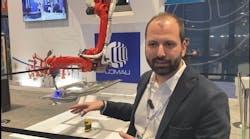Electroimpact in Mukilteo, Wash., builds complete automation assembly systems for commercial aircraft wings, riveting machines and tools for wing panel and fuselage assembly, advanced fiber placement machines, robotic assembly systems and spacecraft transportation equipment.
Laurence Durack, lead electrical engineer, finds new engineering hires need further training in the basics.
“The subjects covered by educational institutions are changing, especially for EE degrees,” he laments. “With the ever-increasing areas of specialization, institutions are dropping the fundamentals from the curriculum. I’ve interviewed many EEs with very good qualifications on paper, but who in reality are very weak in areas such as basic physics, ac circuit analysis or transformers.”
On the other hand they are all very well-versed in software and have no problem picking up any specialized programs from suppliers. “The problem is they rely on the software to solve everything, when in reality what they are trying to achieve is impossible as they miss some fundamental issues. I’ve had candidates who can’t draw a sine wave, have never studied transformers and have told me it’s all dc now and there’s no ac.”
So Electroimpact does its own training. “We use a combination of supplier training and on-the-job training,” says Durack. “For an initial introduction of a new technology we may use supplier training, but as our knowledge increases we rely mostly on in-house on-the-job training. The in-house training is by far the best as the training is focused directly on the application.”
Learn More: Innovative Methods of Instruction Take Training Out of the Classroom
Still, Electroimpact likes getting a supplier to do training on-site.
“This is beneficial for two reasons,” he explains. “The training is focused on our area of application, and groups from different departments can get together for cross-pollination of new ideas. As long as the supplier focuses on the technical side, I’m happy. Recently we had a class on Profinet, and I had a very positive response. We are just starting the switch from Profibus to Profinet, and it was really informative. Furthermore, I put all the information they gave me on our network for online learning. It’s not only great for people who missed the class, but also as a general reference in any of our locations around the world.”



